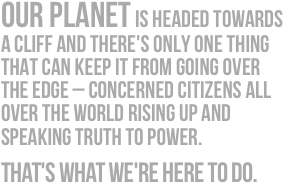or “Technology Transfer to date in the negotiations”
by Anjali Appadurai
One of the more concrete outcomes from Cancun last year was the establishment of a new “Technology Mechanism“. This cross-cutting mechanism was intended to be the place where the entire technology transfer cycle across the Convention could be managed. The Tech Mechanism consists of two parts: the Technology Executive Committee (TEC) and the Climate Technology Center and Network (CTCN). These two bodies are meant to work together to facilitate north-south and south-south flows of clean technology to help countries meet their emissions reduction targets.
The TEC is the policy arm of the Tech Mechanism; it guides the direction and strategy for technology development and transfer under the Convention. Made up of 20 executive members elected by the COP, the TEC is supposed to have equal representation from the global North and South.
The CTCN is a bit of a nebulous concept. It stands for Climate Technology Center and Network, yet to date no one really knows (Parties included) whether the Center and the Network will be two separate bodies or one integrated thing. Since the chair and vice chair of the TEC were decided in Panama (after lengthy discussions on whether a developed or developing nation official should have been the first Chair and vice-Chair, even though the positions rotate annually), the CTCN was the focus of half the discussions on tech transfer. It was handled under the subsidiary bodies (SBI/SBSTA).
Since the juicy stuff – IPRs and trade measures – were taken off the COP agenda and moved to informal meetings, us mere Observer parties were left with the dry bones of “host of the CTCN” and “modalities and procedures of the TEC” as topics to follow in negotiations. In case you’re already bored, I’ll try to make it as readable as possible.
Under the subsidiary bodies (the SBI and SBSTA), the talk centered around choosing the host for the CTCN. Discussions – both open and informal – laboured on for days before one of the co-chairs finally pointed out that there was no definition of “host” neither was there any definition of whether the CTCN would consist of a center, a network, or a combination of the two. This only made negotiations even more convoluted, and no decision was reached. There is, however, a detailed document elaborating how Parties may go about proposing a host, as well as an exhaustive list of criteria for this undefined host figure. The decision on this will probably be made sometime in early-mid 2012, but for now, I heard some juicy rumours floating around (some people in the YOUNGO working group on tech transfer are really good at sneaking up on negotiators and eavesdropping on their conversations).
First, a bit of background: India brought up a controversial proposition in one of the CTCN meetings. They called for increased financial support of the CTCN from the Global Environment Facility. The GEF, keep in mind, is a partner (and puppet) of the World Bank. Channeling funds from them into the CTCN would immediately give the WB influence over the CTCN’s activities – so this was already a contentious suggestion. A delegate from the Philippines later explained to me that India did this (and was supported by several other developing countries) as a way to get at least a bit of funding for the CTCN. The alternative would be the private sector initiatives pushed forward by the US (which, by the way, did get mentioned in the final decision because the US pushed so hard for them).
The first piece of gossip in the tech transfer hallways is that the GEF is putting in a bid to be the host of the CTCN. This would be a disaster for the future of tech transfer. The Technology Mechanism was created as a new mechanism last year, and the hope is that it will be fully operationalized by next year – there is great hope in this new beginning, and great potential for good things to be done to improve the flow and quality of technology to countries that need it. Instead, if the GEF ends up as the host, there would be a permanent WB presence in the tech transfer cycle.
Another rumour is that an Indian non-profit organization called The Energy and Resources Institute (TERI), headed by Dr.R.K. Pachauri (also the head of the IPCC, which is the scientific body responsible for providing the “official” climate science to governments), is planning to put in a bid for host-ship. TERI aims to create “an environment that is enabling, dynamic and inspiring for the development of solutions to global problems in the fields of energy, environment and current patterns of development, which are largely unsustainable” (check out http://www.teriin.org). Now what a change in tune from the GEF! Moreover, TERI is based in India, which would place the CTCN leadership in the global South, where technology transfer should rightfully be based!
So there’s an update on the status of the Technology Mechanism. The latest (from today) is that the shortlist of hosts ranked in order of preference will be compiled by next August, and the host decided upon at COP18. Then maybe this Mechanism can finally get off the ground. So stay tuned!


